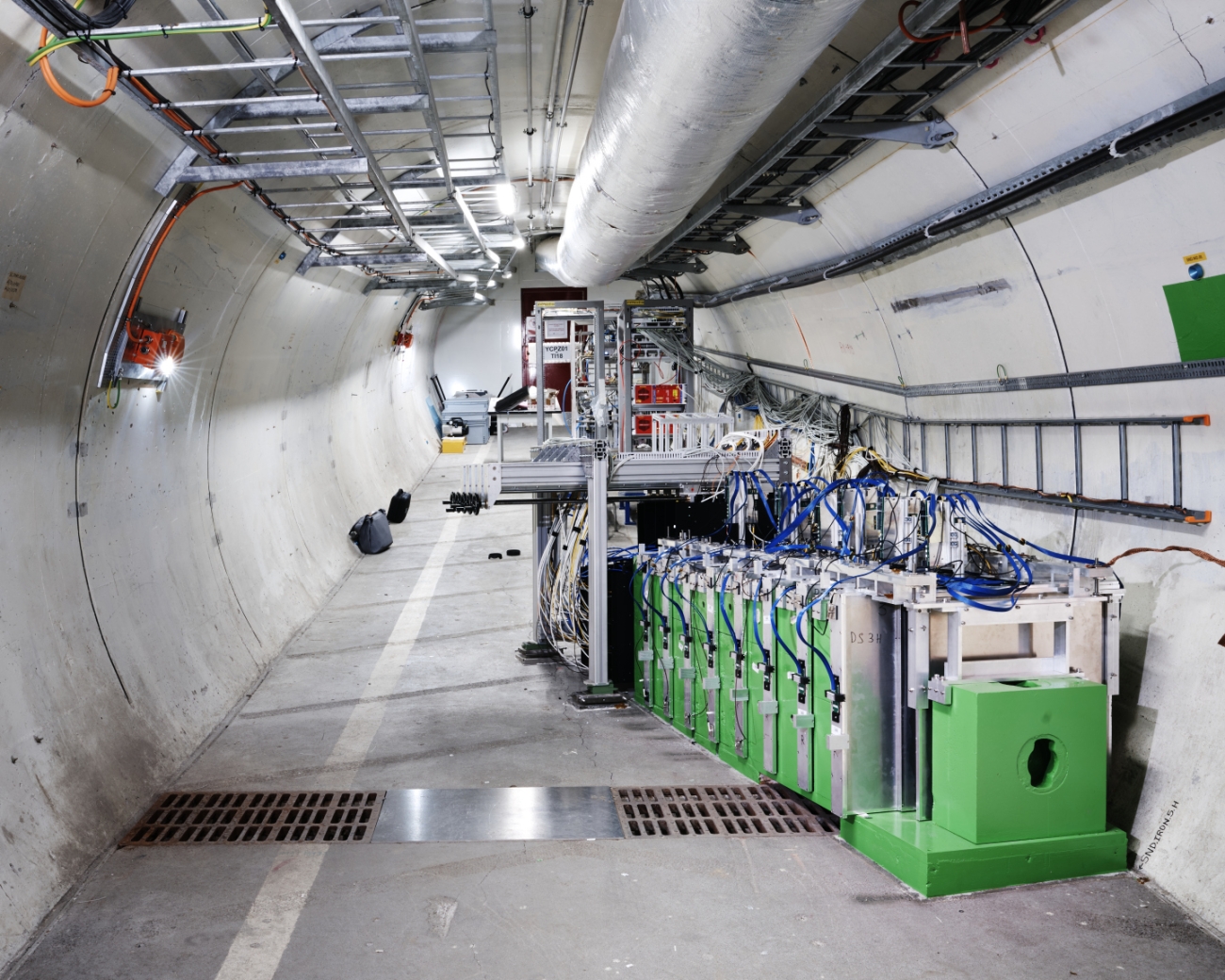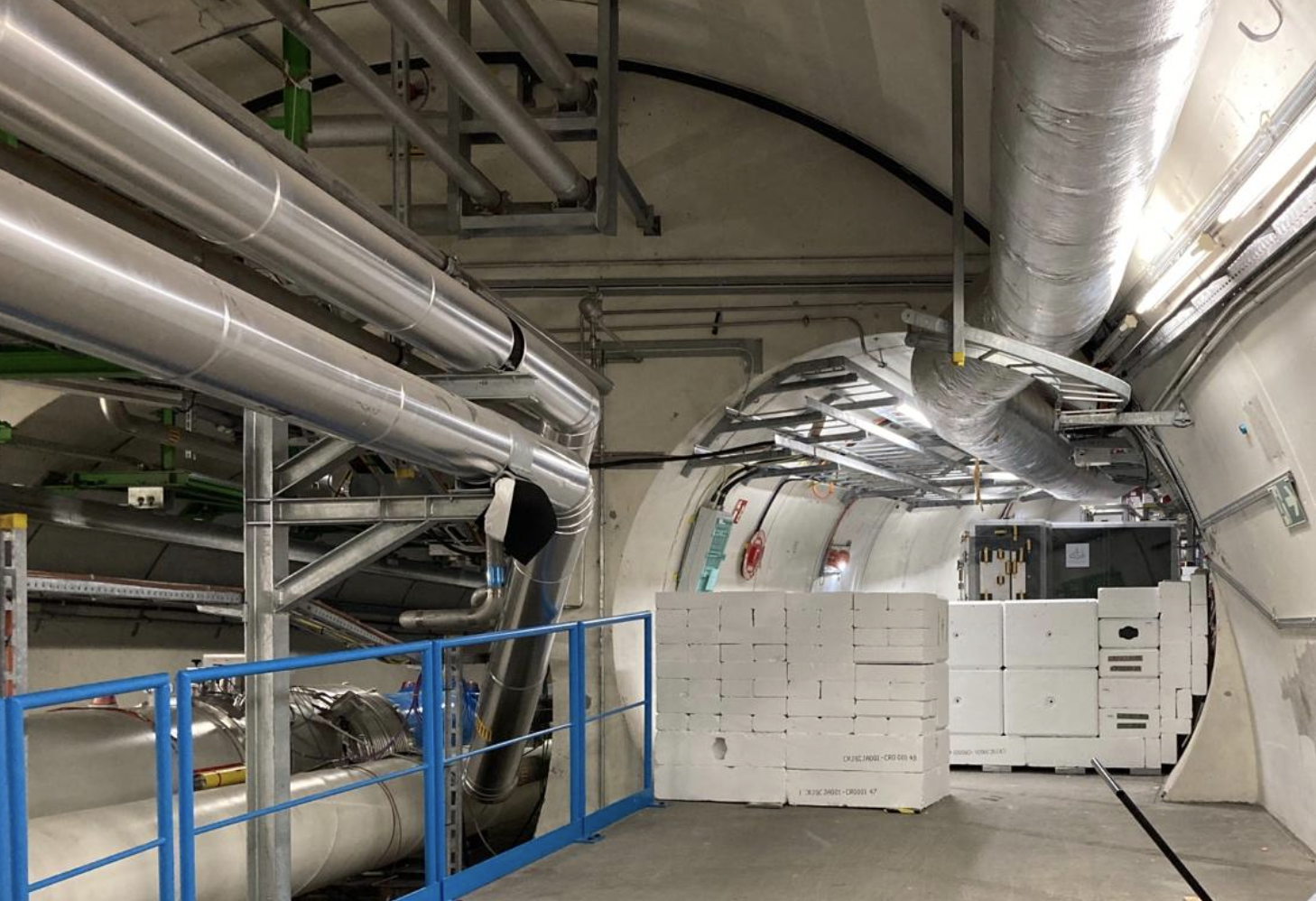Chronicles of SND@LHC’s first year of data taking

The year 2022 saw the culmination of 18 months of intense preparatory work with the SND@LHC Collaboration entering the highly anticipated phase of commissioning with beam and first year of data taking. After the installation of the neutron shield surrounding the target in March 2022, a small fraction (1/20) of the neutrino target was instrumented with emulsion films in the beginning of April to study backgrounds during the beam commissioning. The electronically readout detectors had already been continuously taking cosmic ray data since the beginning of 2022. In April and May, the detector recorded the so-called LHC “splash” events, by detecting the products of the clockwise pilot proton bunches intercepting the tertiary collimators on the left side of ATLAS, 630 m away, as well as those produced on the tertiary collimators right of ALICE by the counter-clockwise bunches, about 3km away. On May 24th, it also registered the first muons from proton-proton collisions. And needless to say, jointly with the other LHC detectors, the 10th anniversary of the Higgs Boson discovery on the 4th of July was celebrated by the recording of the first ever events at a centre-of-mass record energy of 13.6 TeV on the 5th of July.
The data acquisition rate during the period without beam was ranging between 4 and 10 Hz, dominated by noise hits on top of the cosmic-ray muons crossing the detector. When collisions started, the rate was dominated by passing through muons originating from the collision products at IP1. The rate of muons and the corresponding DAQ rate were steadily increasing with the instantaneous luminosity throughout 2022 according to expectation, to finally reach a maximum value in 2022 of 5.4 kHz on November 21st when the LHC achieved last year’s record luminosity of 2.5 x 1034 cm-2 s-1.
Besides the 2 m2 of emulsion films installed during the beam commissioning, the first full batch of emulsion films, produced in Japan and Russia, were delivered at the beginning of July. The assembly of the target walls with emulsion was done with dedicated tools in the dark room of the CERN Emulsion Facility. The ready-to-use target walls were transported to the AWAKE-TCC4 access tunnel for temporary storage, to reduce the integration of tracks in the emulsion from cosmic-ray muons.
Muons integrated during the transport from the emulsion production site to CERN are not a concern because the films are mixed in order and orientation when they are packed with the tungsten plates in the target walls. Thus, the “tracklets” in the films are randomly spread, avoiding reconstruction of tracks in the reference system of the assembled target wall. On the contrary, muon tracks integrated after the assembly may look like those produced by proton collisions, except for the different slope distribution. Hence the need for the short-term storage location in the AWAKE-TCC4 access tunnel. On July 26th, the assembled walls were installed in the detector in TI18. A similar procedure was used for the other two full batches installed later in the year. This first full batch stayed in the detector until September 13th, integrating a luminosity of 10.5 fb-1. On the same day, the second full batch of emulsion was installed. It was initially meant to stay until the end of the run in the initial schedule. The films from the first batch were quickly developed in the emulsion facility and dispatched to the emulsion scanning laboratories, finally putting the reconstruction software and analysis tools to the test!
The energy crisis affecting all Europe led CERN to take actions and shorten the 2022 LHC run by two weeks to end on November 28th. This in turn implied a change in the overall LHC beam delivery strategy, in particular, the cancellation of the heavy ion run in 2022, and extension of the proton-proton run until the end of November. The additional three weeks meant that the second batch would have integrated an expected total of 30 fb-1, corresponding to a muon track density too large for an efficient track reconstruction in the emulsion films. As the decision to extend the proton run was taken after the installation of the second batch, the collaboration was faced with the challenge of finding a solution to producing a third batch of 44 m2, to be installed little over a month later during the first week of November. After intense discussions with Nagoya University and the MISiS University, a huge effort and rescheduling at the production facilities allowed producing and delivering the third batch on time! Films were delivered at CERN on November 1st, the installation of the target underground was performed on November 4th. The second target integrated a luminosity of about 21 fb-1 and the third one about 9 fb-1.
As it was not always possible to schedule the replacements of the target walls within the Technical Stops of the LHC machine, the collaboration has developed a fast procedure with minimum manipulations to replace the target walls. As a result, the replacement team managed to do the work within four hours from entering to leaving underground in the last replacement!

Overall, the year of data taking was very stable with very few problems. The main incident was the failure at the beginning of October of one of the two CAEN mainframes, hosting the power supply boards for all the detectors. This left the detector off until access was granted two days later, leading to a loss of about 0.8 fb-1. The issue turned out to be a failure of a power transistor, most likely induced by a single event latchup. This triggered the implementation of additional shielding against secondary hadrons coming from the machine. The shield was put in place during the YETS, and it is now ready for the 2023 Run. The incident with the CAEN was the main source of loss of data taking. At the end of the year, the SND@LHC detector had a data taking efficiency higher than 96%. The three emulsion batches together integrated about 40 fb-1.
Besides the detector commissioning, the main goal of the first year of data taking was the measurement of the backgrounds in order to consolidate the first neutrino observation and the subsequent neutrino studies. Muons are by far the most abundant particles entering the detector. The rock upstream of the detector provides a shield against hadrons and absorbs soft muons. Moreover, muons are in general swept out along their path through the LHC machine elements. Nevertheless, several billions of muons have entered the target region during the 2022 Run. Muons travelling through the rock and the concrete of the tunnel wall undergo deep-inelastic scattering and produce neutral particles which can enter the detector without being detected by the veto stations. The analysis of the time distribution of muon track hits and of the track direction allowed to identify the source of the tracks, thus estimating the contribution due to the machine-induced background. The collaboration has estimated the muon flux to be 1.9 x 104 muons per cm2 per fb-1 and the paper is now in preparation.

Event display showing one event with three reconstructed muon tracks in the final state. Two projections (top and side views) are shown.
During the study of the muon rate, relatively rare events have also been observed, such as those characterised by the presence of two or more muons in the final state. The measured rate is not compatible with the pileup of single muon events, and this proves the source to be a genuine process. For instance, the observed events with three muons in the final state could be due to trident production induced by a penetrating muon. The event display below just shows one of these events with an incoming muon crossing the veto plane and producing three outgoing muons, one of them with a slope compatible with the incoming one. Among the other two muons, one is ranging out the detector while the other one is fully contained, and its momentum is estimated to be about 1 GeV.
The search for muon neutrino interactions in the target is already ongoing, starting from only the data recorded by the electronic detector, while the emulsion is being scanned, reconstructed, and analysed. Several candidates have been identified on top of a very small background. The paper is in preparation, stay tuned!
